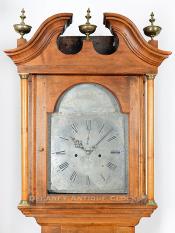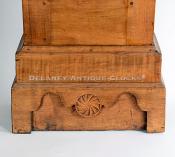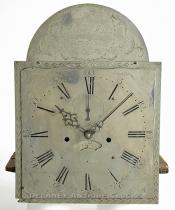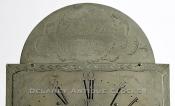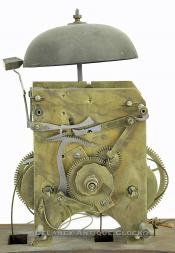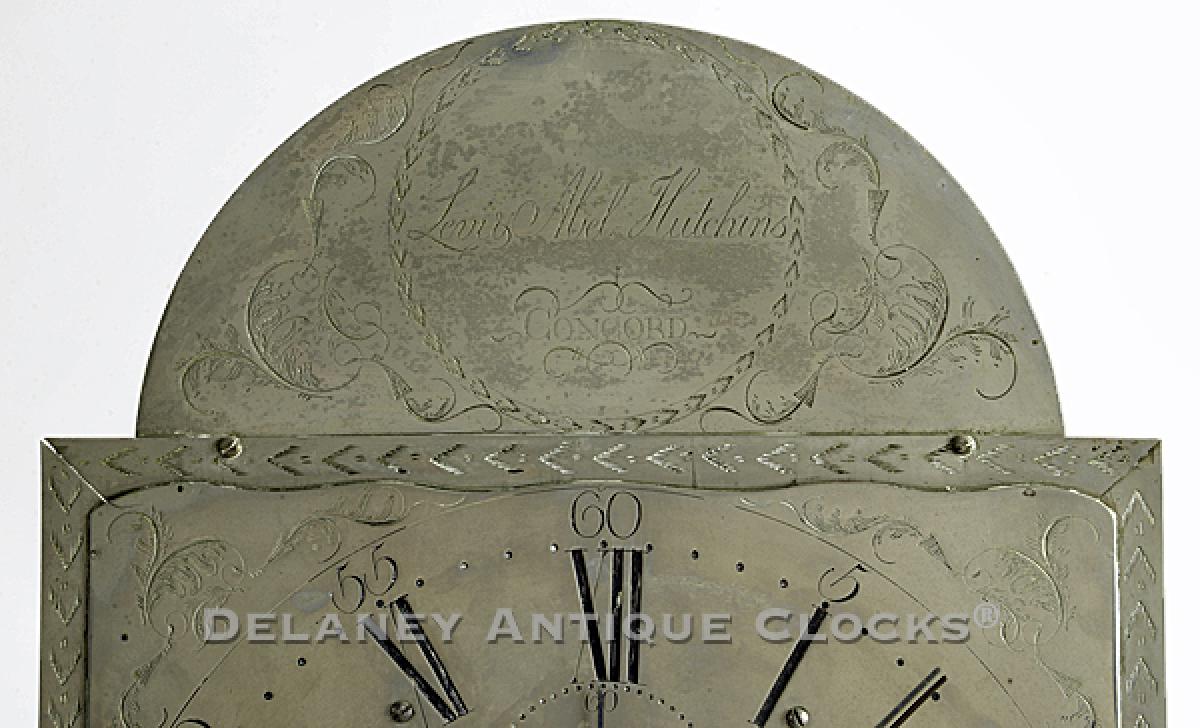Levi & Abel Hutchins of Concord, New Hampshire. A tall case clock. A very early example. 219010.
This is an excellent example of a tall clock made by New Hampshire's premier clockmakers, Levi and Able Hutchins of Concord, New Hampshire. This early example was made shortly after the brothers settled in Concord. This case form is seldom seen and is, in my opinion, one of the more attractive forms today. This maple case is constructed in a manner that case furniture was built in the day.
This example is formatted in the traditional woods that one would expect from the Concord, New Hampshire, region circa 1785. This case is constructed in maple and features some selections that exhibit tiger maple striping. The surface or finish appears to be approximately 50 years old. It is light, and as a result, the grain pattern exhibited in the wood is well displayed. The base of this example features unusual construction. It should be noted that it is somewhat compressed and that the bracket-style feet are applied to the three sides. To be clear, they are not applied to the bottom of the case. The base panels extend below the feet and reach the floor. The feet are formed with good height and center a carved pinwheel in the design. We have seen at least four Concord clocks sharing this very same case detail. The waist section is long and is fitted with a large rectangular-shaped waist door. This door is trimmed with a simple molded edge. Through this door, one can gain access to the two tin can drive weights that power the movement and the brass-faced pendulum. The bonnet can be easily described as a swan's neck form. But this only tells part of the story. It is constructed in a manner that is similar to a chest-on-chest or highboy of the period. The top of the hood features elements that are fully enclosed. I am very fond of the detail. The arch moldings are boldly formed and exhibit more vertical height than the vast majority of the typical Concord case styles. Three cast brass finials are mounted at the top of the bonnet. These period finials are most likely original to this clock. The bonnet columns are turned smooth and mounted into brass capitals. The bonnet door is an arched form and is fitted with glass. The sides of the hood are fitted with large rectangular windows. These are fitted with glass. Looking through these opens, one can see the brass gearing of the mechanism. The back of the hood is framed with vertical boards that the smoothly-turned quarter columns are attached to.
The dial is brass and finished in a silver wash. It is made up of six separate pieces that are riveted together. They are richly engraved with decoration. This includes the time ring, which is formatted in Roman-style hour numerals, Arabic five-minute markers, a date of the month calendar, seconds dial, floral decorations, and the Maker's signature. This dial is signed in the arch "Levi & Abel Hutchins / Concord."
This fine movement is constructed in brass and is of good quality. Four-turned pillars support the two brass plates. Hardened steel shafts support the polished steel pinions and brass gearing. The winding drums are grooved. The escapement is designed as a recoil format. The movement is weight driven and designed to run for eight days fully wound. It is a two-train or a time-and-strike design having a rack and snail striking system. As a result, it will strike each hour on the hour. This is done on a cast iron bell which is mounted above the movement.
This clock stands approximately 7 feet 7 inches tall and was made circa 1785.
Inventory number 219010.
Levi Hutchins was born in Harvard, Massachusetts, on August 17, 1761, and died peacefully on June 13, 1855. He was 93. His remains were interned in the Friends' burial ground in Concord, New Hampshire. Interestingly, this was a society he somewhat withdrew from several years before his death. Levi was one of eleven children. His parents were Colonel Gordon Hutchins & Dolly or Dorothy Stone. Levi had a younger brother named Abel, born in March of 1763. He also became a clockmaker and, for a time, worked with his brother in a partnership. Able died in the town of Concord on April 4, 1853. Both men lived into their nineties and lived long, prosperous lives. I have listed some of Levi's life's highlights below.
In 1772, their father moved the family from Harvard, MA, to Concord, NH. In Concord, he purchased land and buildings and commenced as a storekeeper. Gordon became active in the revolution and served as a Captain in the local regiment. Young Levi served in his regiment as a Fifer from April to September 1775. In May of that year, Gordon Hutchins marched to Breeds Hill under the command of Colonel John Stark. Young Levi accompanied them and watched the battle from a distance high on the hills of Medford, MA. Levi also witnessed the burning of Charlestown. His father, Gordon, was later stationed at Winter Hill until the end of that year. Levi enlisted in Captain Lewis' Company, in Colonel Varnum's Regiment, under General Green. In the spring of 1776, he marched to New York under the orders of General Washington to protect the city. He was posted in Brooklyn for a while. He remained posted on the island of Red Hook, which is located 4 miles from New York and is situated to protect the harbor until the defeat of the Americans in the battle of Long Island. Levi was honorably discharged and returned to New Hampshire on horseback.
Levi was well educated. He attended Byfield Academy for one year and Andover Academy for two quarters. He was then recruited as a school teacher and taught in Tewksbury, Pembroke, and Ashburnham, Massachusetts.
On December 6, 1777, the two brothers entered an apprenticeship with the ingenious Grafton, Massachusetts clockmaker Simon Willard. At this time, Levi was sixteen, and Abel was fourteen years of age. After Levi served his 3-year indenture to Simon, he traveled to Abington, CT, to serve an eight-month apprenticeship in the watch repair trade.
Levi may have moved to Concord, New Hampshire, as early as 1782. Here, he set up a residence and shop on Main Street in the central village. His first shop was near the railroad passenger depot, just a short distance from the junction of the Merrimack River and the roads from Boston, Portsmouth, and the Connecticut Valley. Soon after Levi arrived, his brother Able moved up from Roxbury, MA, having worked with the Willards for a few years. Together, they formed a partnership that lasted until about 1803 and became the most prolific clockmakers in the Concord region for several years. Based on the number of examples that trade in the marketplace, their output of tall case clocks was substantial. The earliest known advertisement helps date their partnership. It was published in 1788 in the New Hampshire Spy. They placed an ad in the Concord Herald in 1790 and again in 1792, looking for two apprentices. It is thought that Peabody Atkinson and Jesse Smith answered the ad and trained under them. Both men are recorded as working as farmers in Virginia in their later years.
On February 23, 1789, Levi married Phoebe Hanaford, daughter of Benjamin, and Ruth Hanaford of Haverhill, MA. Together they had ten children. Levi made each one of them a clock before he passed.
In 1793, Levi and Abel purchased a farm three miles away on the western side of Rattlesnake Hill. Here, they continued to manufacture clocks and also began to farm.
In 1807, their partnership was dissolved. Abel bought Levi's share of the business and paid off all debts. Levi received the farm and opened his own shop opposite Gale's Tavern. Abel retained the house, the original shop, and the parcel of land. On Tuesday, November 25, 1817, these buildings were consumed by fire. Two years later, Abel erected the Phoenix Hotel.
In 1808, Levi purchased a house on 70 acres, including an apple orchard, a dilapidated fort, a large barn, a woodshed, and later a sawmill on Long Pond in the West Parish or West Concord Village.
After the War of 1812, in about 1815, Levi built a large building and set up five looms to manufacture cloth. The cloth business lasted three years before it became unprofitable and sold off. One room in this barn was used for clockmaking. Levi continued to work on brass clocks for 20 years. The sawmill operated for 50 years.
JAD


